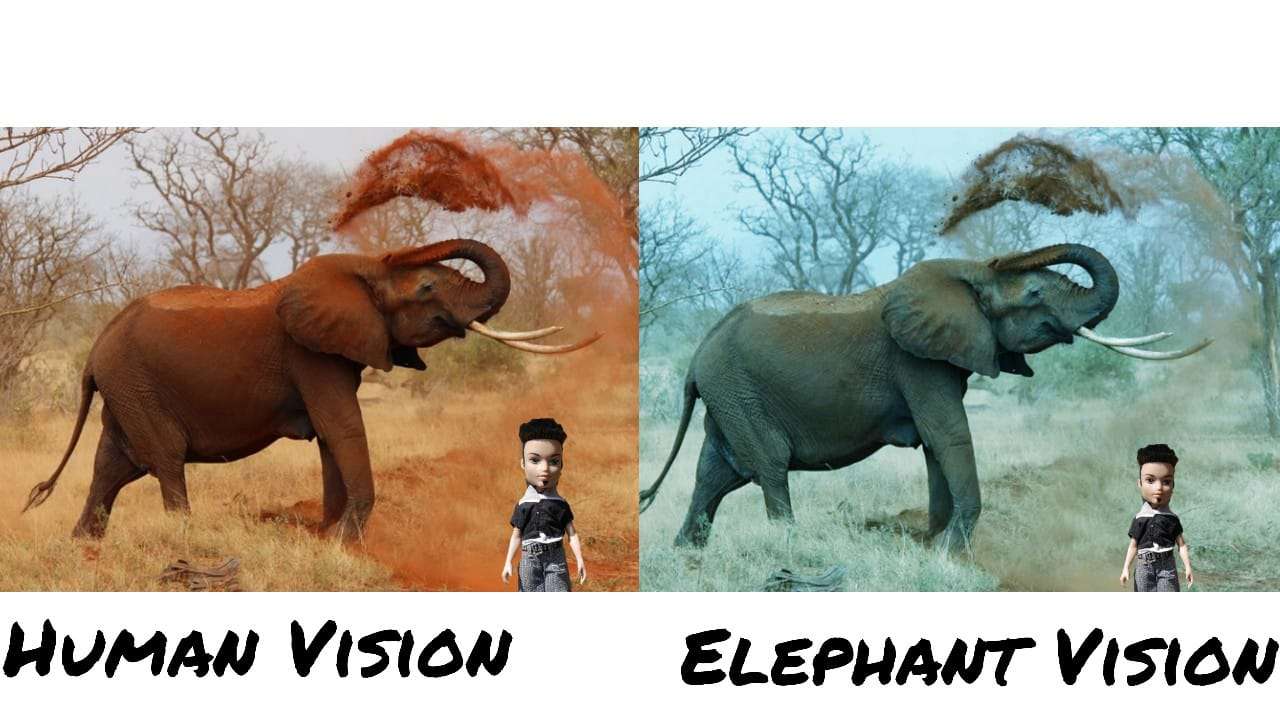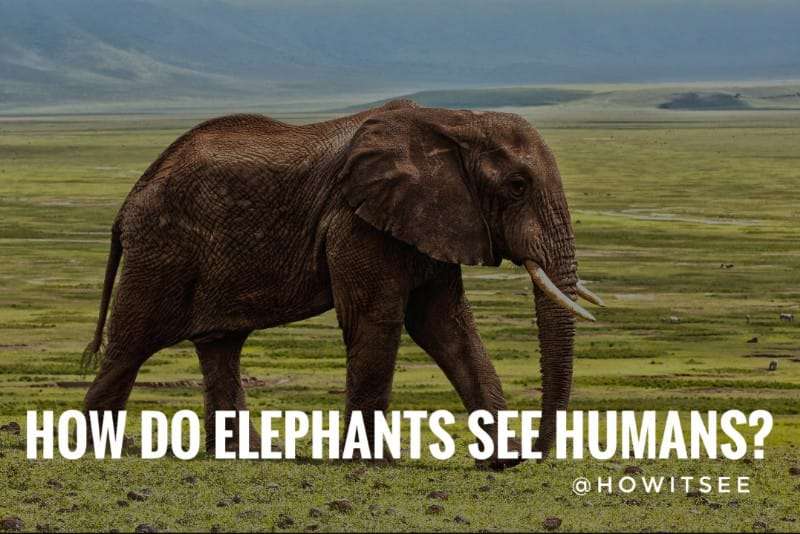Elephants are the largest land animal from the proboscidean family Elephantidae. Many elephant owners recognize them as cute and friendly. We all have seen elephants at least once in our lifetime.
So, have you been fascinated by how do they see, understand or recognize humans?
The answer to the question “How do Elephants see humans” is: Wild elephants see humans as a threat, whereas trained elephants understand us as friends. Elephants have poor eyesight; they understand or recognize our vocal commands. They see humans in blue and yellow color shades through their visual cues.
Elephants are not entirely color-blind. They perceive the world in different color shades.
Later in this post, we have explained much on elephants’ vision and “how they see the world in day and night,” along with other relatable queries. So, without any further delay, let’s begin.
How do Elephants see Humans?
Elephants have poor eyesight and are dichromatic. They see humans in less color as compared to us. It implies their eyes have only two cones sensitive to red and green.
On the other hand, humans are trichromatic and have blue, green, and red cone cells. Due to being dichromatic, elephants perceive the world in the shades of blue and yellow.
Also, with their eyes, they can differentiate us from other animals but not from other humans. For this, they are more reliable on their hear and smell.
According to the research, elephants are not able to recognize visual cues provided by humans but are responsive to vocal commands. It represents they distinguish us with our voices.
As per the study, it is analyzed that wild elephants categorized humans as a predator like lions. Therefore, it is suitable for everyone to maintain distance with them during jungle safari.
However, trained elephants who spend most of their time with humans have friendly nature. They rely on us for their survival and loves to connect with us.
What colors do Elephants see?
Elephants can see blue and yellow colors but cannot differentiate red and green shades. They are not completely color-blind. They see fewer color shades as compared to humans.
Elephants are dichromats and have only two color-sensors or cone cells, i.e., red and green. In comparison, humans are trichromats and can perceive all three colors, red, green, and blue, of different wavelengths.
It ascertains that, unlike humans, elephants cannot distinguish reds from greens. They perceive both colors as gray-shade.
They miss the third cone and witness the world the same as humans but with different colors. Below we have attached an image to illustrate how elephants see the world.

(Elephants can see black and white colors)
As shown in the image, elephants can apprehend mostly the shades of blue and green along with white and black. The vision for White and Black is same as ours. Therefore, it is always recommended to avoid wearing Blue, Pink, White and Black colors during the elephant safari.
There are two types of photoreceptors in the retina: cones and rods. Cones are responsible for color vision, and rods help to sense the light. In the cones, humans have the upper hand; however, based on the rods, elephants surpass us.
Elephants exhibit arrhythmic vision means they are both diurnal and nocturnal.
Humans are diurnal and cannot perceive anything in the dark, whereas elephants can glimpse well in the day and have the ability to see well at night too.
The rods in their eyes have the capability to sense more light in the low-light condition.
Can Elephants see at night?
Elephants can see much better than humans at night. They are sensitive to the environment at night that comprises primarily blue and violet light of a small wavelength.
The retina in their eyes can quickly adapt to the wavelength of light at night, i.e., blue color shades. The rod-free areas can perceive the slightest of dim light, allowing them to see in the dark.

During the full moon, elephants glimpse the surroundings as bright as day. It is all due to the presence of tapetum lucidum. According to the research, it is noticed that African Elephants have tapetum lucidum in their eyes.
It is a thin reflective tissue that helps to reflect even the slightest of light back to the retina, giving the ability to glimpse better in low-light conditions. In addition, Research Gate mentioned that the tapetum lucidum of elephants is similar to that of artiodactyls.
However, it is not as reflective as in other mammals, suggesting that they are capable of seeing at night but not to the degree of nocturnal carnivores.
The presence of a tapetum lucidum indeed helps elephants for night foraging. But they cannot see as good as other nocturnal predators. It means there is a limitation in their night vision. Also, they cannot notice anything like many animals in the pitch dark.
In contrast, humans have the best daylight vision but do not have the ability to visually glimpse in the dark. Below we have discussed the sleep cycle of elephants at night.
Do Elephants sleep at night?
In the wild, elephants sleep at night only for two hours. However, in zoos, they sleep for four to six hours, according to the research.
Many scientists tracked there are many dangers in the wild; therefore, to protect their families, elephants rested for only two hours, mainly at night.
In nature, they also travel long distances for food and water and stay awake for several days.
How do Elephants see the world?
Elephants see the world in blue-yellow shades. They have only two cones that allow them to identify the variation of blue and green colors, not red.
They are dichromatic, which means they have a large wavelength cone missing in their eyes. That’s why they see the world in blue, yellow, and gray shades.
On the other hand, humans have trichromatic vision with the presence of small, medium, and large wavelength cones. Hence, we can see millions of color shades ranging from 380 nm to 720 nm.
Rods in the eyes helps to distinguish the world in low-light condition, whereas cones in the eyes assist in recognizing millions of color shades.
Unlike humans, elephants view the surrounding with clear vision up to 25 feet and with fewer color shades. After 25 feet, their eyesight starts to become a blur.
How far can Elephants see?
Elephants can clearly see only up to 10 meters and can distinguish objects up to 25 meters with their vision.
They have small eyes and limited peripheral vision that allows them to witness the world plainly with the range of 25 to 32 feet. Unlike us, they cannot see very far objects. Their eyesight is weak compared to humans.
Elephant vision vs. Human vision
| Elephant Vision | Human Vision |
| Are dichromats | Are trichromats |
| Differentiate only blue-green shades | Differentiate millions of color shades |
| Can see in the dark | Cannot see in the dark |
| Vision is up to 25 to 32 feet | Vision is up to 3 miles. |
Here, we conclude our article on “How do elephants see humans and the world,“ along with other queries. We hope this post is knowledgeable for you. We will be back with another post. Till then, stay tuned with us and read the articles below.
Frequently Asked Questions
Q1. Do elephants have poor eyesight?
Ans. Yes, elephants have poor eyesight.
Q2. Can elephants see color?
Ans. Yes, elephants can see shades of a blue-green color.
Q3. Do elephants understand human language?
Ans. Yes, elephants can recognize different human languages and voices and can even distinguish man, woman, and child based on voices.
References
Are Elephants Colorblind pdf by Elephanatics
Science Environment by BBC
Research Gate
Also Read:

Meet Monty, the visionary founder of How It See, being an engineering student, he’s fueled by an insatiable curiosity about the world around him. He is captivated by an eclectic correlation between animal groups, science, and nature, and this fascination drives his quest for understanding.
After completing his degree, he’s set on a mission to delve deep into the realm of nature, accumulating knowledge to share with you through his writing. In the meantime, he loves to watch anime and read anime.

